Introduction
The word of the Lord came to me: 2 “Son of man, how is the wood of a vine different from that of a branch from any of the trees in the forest? 3 Is wood ever taken from it to make anything useful? Do they make pegs from it to hang things on? 4 And after it is thrown on the fire as fuel and the fire burns both ends and chars the middle, is it then useful for anything? 5 If it was not useful for anything when it was whole, how much less can it be made into something useful when the fire has burned it and it is charred? 6 “Therefore this is what the Sovereign Lord says: As I have given the wood of the vine among the trees of the forest as fuel for the fire, so will I treat the people living in Jerusalem. Ezekiel 15:1-6
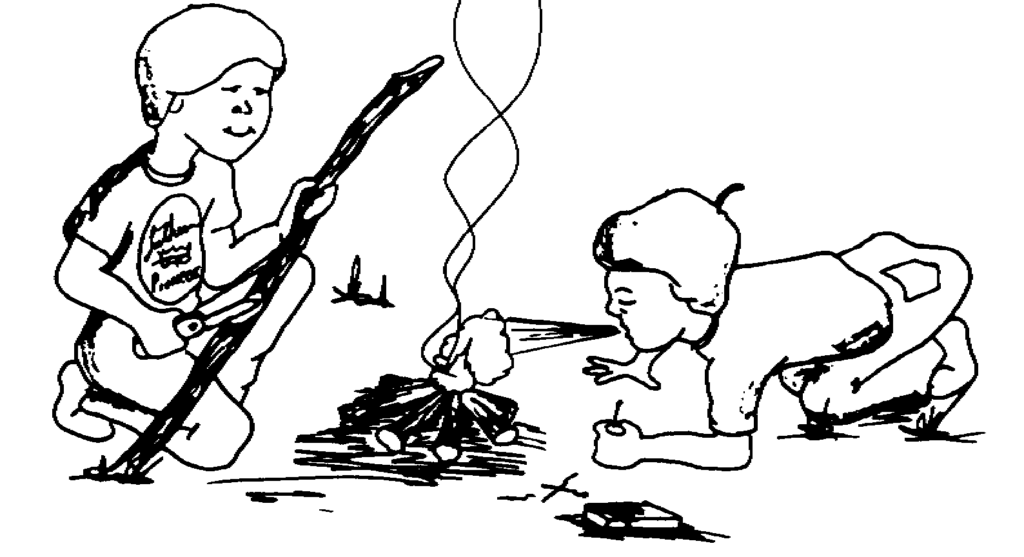
David loved King Saul because Saul was chosen by God to rule his people. Saul did not return that love. Within his heart a raging fire burned out of control and countless times he tried to kill David. The fires of jealousy can destroy a man just as quickly as a roaring forest fire. Play with fire of either sort and you will get burned. Thank God that you have been rescued from the fires of hell by your loving Lord. Now be careful with every sort of fire.
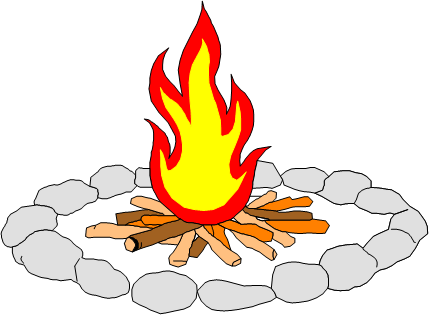
For centuries, fire has been both a friend and a foe to man. A fire can keep you warm, dry your clothes, cook your food and cheer you on a dark and gloomy night. An evening campfire, whether in your back yard or in a National Forest, draws people together in a bond of friendship and peace, but that same fire can turn quickly from a friend to a foe if you are careless. Smoky Bear says, “Only you can prevent forest fires.” Before you go camping this year it is important that you learn how to start, control, and put out a fire.
There are many different types of fires but only three uses. A fire can be used to cook your food, to warm you when you are cold, or to provide entertainment during a campfire program. Before building any of these fires it is important that an area for the fire be prepared, and all the materials gathered that will be needed.
What Does a Fire Need to Burn
A fire needs three things to burn.
- The first thing a fire needs to burn is air. Fire needs a ready available supply of air to burn. A fire needs an unrestricted air supply to burn effectively and to keep burning. If the fire does not have this air supply readily available the fire will smolder and go out.
- The second thing fire needs to burn is fuel. Fuel is wood, branches, paper, pine needles to name a few.
- The third thing a fire needs to burn is a heat source. This can come from a match, a lighter, a flint and striker set, or by rubbing two things together to generate heat.
Without all three of these elements a fire cannot be started.
Preparing the Site
The campfire should be built in the center of a circle that has been cleared of all burnable materials. A small fire requires about a six-foot circle and a large council fire requires a ten or twelve-foot circle (see Figure 1). Not only should all of the burnable materials be cleared from around the fire on the ground, but from overhead as well. Never build a fire under a small tree or low overhanging branches.

Building the Fire Ring
Look around in the area where you plan to build your fire. Locate stones or rocks of any size to be used to form a ring around the space where you are going to build your fire.
The size of the stone ring is going to be dependent on the size or purpose of the fire you are going to build. A cooking fire does not need to be that big and an 18” to 24” diameter fire ring will be suitable for this type of fire. If you are building a fire for heat, light and conversation you will need a larger fire ring of 36” or more in diameter. The entire fire pit needs to be ringed to prevent the fire from leaving the designated spot.
Grass and leaves
burn and these items are not fully removed from the area this can cause the
fire to leave the pit area if it is not fully ringed.
Building a Fire
Before striking the first match, gather all of your tinder, kindling and firewood. As with any fire, using dry, seasoned firewood will burn better and cleaner than wet wood. A lot of people who fail at building a fire, usually fail because they have not gathered enough of the right materials or the materials are wet.
Tinder:
Tinder is any material that lights quickly and burns fast. Some examples of good tinder are birch and cedar bark, dry cattails, dry pine needles, dry weeds and grass, small wood shavings, news paper, paper bags and cardboard. Two large handfuls of tinder should be enough to start the fire.
Kindling:
Kindling is made up of small sticks of dry wood usually slightly larger than the twigs used for tinder. These do not catch fire as easily as tinder, but once burning, will burn hotter and longer than tinder (see Figure 2). Three or four handfuls of kindling, of various sizes, should be enough to keep your fire going until the firewood starts burning. Kindling needs to have sticks of all sizes that range from ¼ inch to 1 inch in diameter.
You will need to have plenty of each size to ensure that you fire starts and stays burning. You place the smaller diameter pieces of kindling on first and move to the larger pieces. Be sure to place the pieces on the fire and do not through them on as you can smother the fire and put it out.
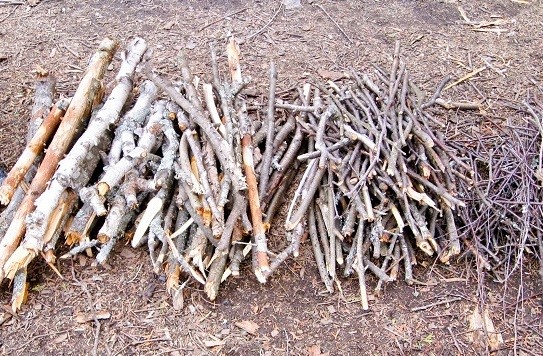
Wood for Fuel:
The type of firewood needed will depend on what the fire is to be used for. When building a quick fire for heat, softwood such as pine, birch and spruce will work the best. Hardwood, such as oak, hickory, maple and ash will provide excellent coals for cooking. Whatever type of wood you choose, the wood pile should have more than enough wood to get the job done. A good estimate of the amount of wood you will need depends on many factors such as what am I going to use the fire for and how long the fire is going to burn. A rule of thumb is that for every 30 minutes the fire is going to burn you will need 6 pieces of fire wood. Using this information a cooking fire that is going to burn for two hours will need 24 pieces of fire wood. If you are building a fire for heat and conversation and plan on having it burn for 4 hours you would need 48 pieces of wood. You need to plan ahead.
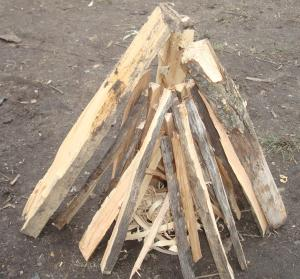
TeePee Fire
To build a fire, take the tinder and place it in the center of the cleaned circle. Build a teepee over the tinder with your kindling. On the upwind side of the fire, leave room between the kindling to light the tinder later. Don’t put too much on or the fire will not be able to “breathe.” Build another teepee over the kindling with firewood, again allowing enough room for air around the tinder and kindling (See Figure 3). Now, with your back to the wind, light the tinder. If the fire has been built properly, the tinder will burn long enough to ignite the kindling and firewood. Once your fire is going, it is important to use only enough firewood necessary to keep the fire going. Too little firewood and it will soon go out. Too much firewood and the fire will be too large. Once the fire is going, never leave it unattended. Remember what Smoky Bear says, “Only you can prevent forest fires.”
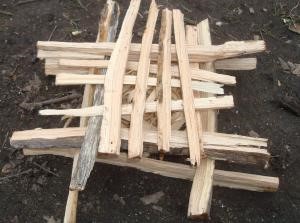
Log Cabin Fire
The log cabin fire design is popular because it’s easy to build, it’s easy to light and it creates a nice hot bed of coals which are perfect for a campfire meal. The log cabin design holds up a lot better than a teepee and doesn’t collapse as easily as the teepee design. Although there are a few variations to the log cabin fire style, this method seems to work best. To begin, place a large pile of kindling in the center of the fire area. These pieces of kindling are criss-crossed in a log cabin design. It’s important to use a lot of kindling for this fire. You want to create a nice hot center inside the structure. If you fail to use a lot of kindling, your fire won’t burn very well. Once the kindling is in place, lay two fairly large logs across from each other on both sides of the kindling. Next, take additional pieces of firewood and lay them in the opposite direction, creating the base of the log cabin. Use wood that has been split into relatively small pieces. Split firewood burns better than round un-split firewood. Next, place another row of wood in the opposite direction leaving a small gap in between every piece of wood. Continue this process a few more times constructing your “log cabin” and your ready to light your fire!
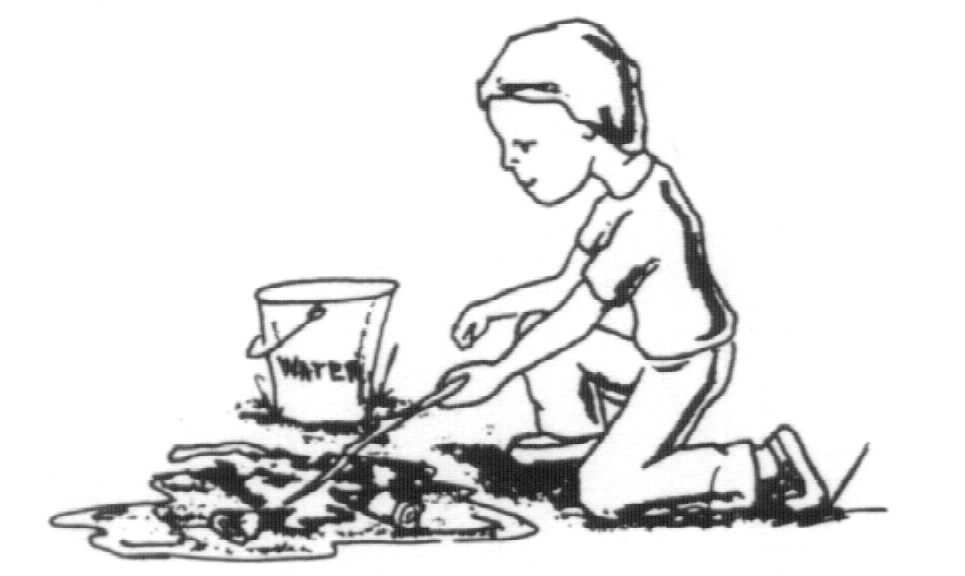
Keyhole Fire
The Keyhole fire is a good all-around fire if you are going to be cooking over the open fire. As the fire burns down to coals, they are pushed to the narrow end of the Keyhole and used to cook your meal.
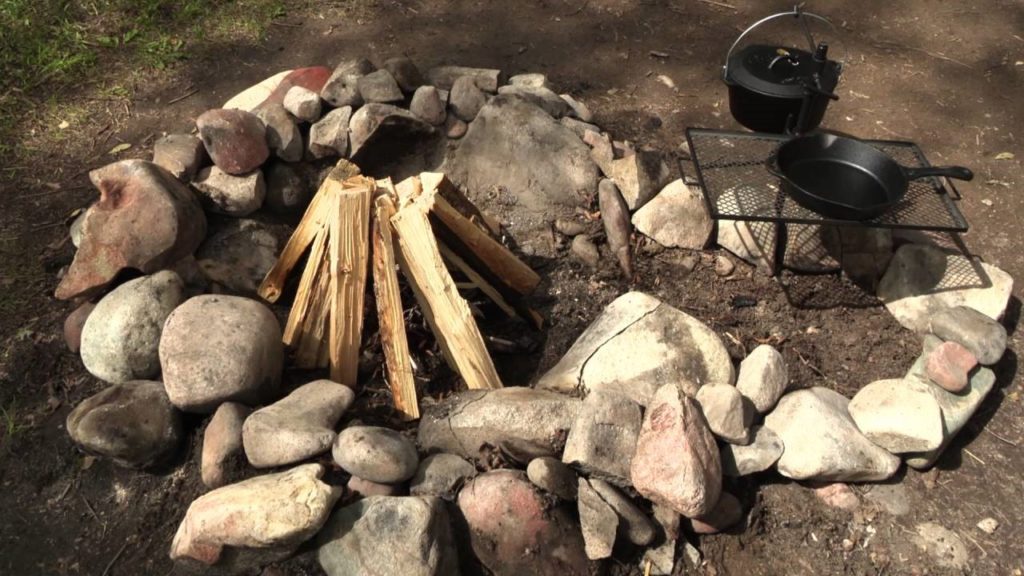
Most campfire camping recipes call for both hot, direct flame heat, and, more controlled heat from hot coals – especially Dutch oven recipes. This layout provides for an area where hot coals can be raked out of the “roaring” vertical fire to a “semi-separate” more controlled “hot coals” area. Campfires are also for sitting around. This “keyhole” layout provides an area for a great campfire to enjoy, and an area of hot coals for cooking.